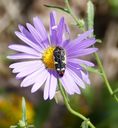Acmaeoderini
Acmaeoderini
Classification
- Phylum: Arthropoda
- Subphylum: Hexapoda
- Class: Insecta
- Order: Coleoptera
- Suborder: Polyphaga
- Superfamily: Buprestoidea
- Family: Buprestidae
- Subfamily: Polycestinae
- Tribe: Acmaeoderini
Pronunciation
How to pronounce Acmaeoderini: //æk.miː.oʊˈdɛr.ɪˌnaɪ//
These audio files are automatically generated. While they are not always 100% accurate, they are a good starting point.
Images






Summary
Acmaeoderini is a diverse tribe of metallic wood-boring beetles within the family Buprestidae, containing over 560 species, primarily inhabiting wooden environments, with a significant ecological role as decomposers.
Physical Characteristics
Metallic coloration, usually small to medium size, with a streamlined body shape characteristic of wood-boring beetles.
Identification Tips
Look for the distinctive metallic sheen on the outer exoskeleton and the presence of elongated body shape; many species show specific color patterns or markings.
Habitat
Primarily found in wooded environments where they can bore into trees and other woody plants; often associated with specific host plants.
Distribution
Acmaeoderini has a distribution across the continent, with greater diversity in the southwestern regions.
Diet
Larvae feed on the wood of various host plants, while adults may feed on nectar or pollen.
Life Cycle
Life cycle includes egg, larval, pupal, and adult stages; larvae typically develop in the heartwood of trees or dead wood.
Reproduction
Mating occurs in spring or early summer; females lay eggs on or near suitable host plants.
Predators
Nematodes, birds, parasitic wasps, and other insects that prey on wood-boring beetles or their larvae.
Ecosystem Role
As wood-borers, they play a significant role in the decomposition of organic matter and recycling of nutrients in forest ecosystems.
Economic Impact
Their wood-boring habits can lead to damage in timber, forestry, and other wooden structures, potentially affecting economic interests in those areas.
Collecting Methods
- Hand collecting from host trees
- Lethal traps with attractants
Preservation Methods
- Drying
- Ethanol preservation
Evolution
Acmaeoderini is part of a larger evolution of Buprestidae, showcasing adaptations to wood-boring lifestyles through their morphology and behavior.
Similar Taxa
Misconceptions
They are often mistaken for similar-looking beetles; however, their metallic sheen and body shape can help distinguish them from other beetle families.
Tags
- Beetles
- Buprestidae
- Acmaeodera
- Wood-boring